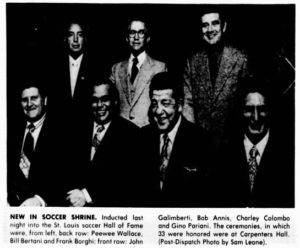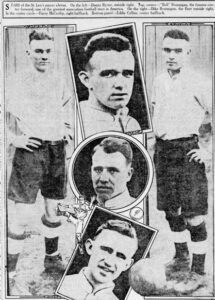Profile Bio Courtesy John Macrath
Daniel Aloysius Byrne came into this world on Thursday, May 14, 1891. His mother Mary Ann (nee Cummings, her parents from Ireland) gave birth to him in the family home located at 1318 N. 19th Street at Phipps St. in the present-day Carr Square neighborhood of North St. Louis. The family later moved to 1411 Laurel St. near the Hamilton Heights neighborhood of North St. Louis. This 2nd home was near Skinker and Easton (now Dr. Martin Luther King Dr), and just a few blocks north of Forest Park. It was the family home until the death of the parents (Dad in 1923, Mom in 1933).
“Danny” as he was affectionately called, was the 3rd youngest of 6 children born to Charles J. and Mary Ann Byrne; namely, Charles Patrick, Mary Loretta, John Aloysius, Daniel Aloysius, William Patrick and Mark Chester.
Their father Charles J. Byrne (1857-1923) had attended Washington University and had also trained as an electrician. He obtained a position as one of the early
employees of Bell Telephone Company on Olive St., probably due to the influence of his well-known father. Charles Byrne started off as a clerk and held many positions, and eventually became a Superintendent at Bell. In addition, he was in charge of construction of the new Bell Telephone building. Likewise, he tried to bring his sons into the electric telephone business, including Danny. Charles was the only one his 4 Byrne siblings to marry and have children.
Danny was named after his famous grandfather, Daniel F. Byrne (1823-1900). Grandpa Daniel Byrne came to America from the village of Avoca, “County Wicklow, the Garden of Ireland”, just south of Dublin. Avoca is known for its copper mines and weaving mills. It is near the east coast on the Irish Sea, and situated on the fork, where the Avonmore and Avonbeg rivers come together to form the Avoca river. The area was the inspiration for the famous song “The Meeting of the Waters” by the well-known Irish poet and song-writer Thomas Moore (1779-1852). Moore is also known as the author of the beloved ole Irish tune “The Last Rose of Summer” (written in 1805), and the famous “Believe Me, If All Those Endearing Young Charms” (originally entitled “My Lodging is on the Cold Ground” 1808). Grandpa Byrne is, no doubt, a descendant of the famous rebel Clan O’Byrne of Wicklow, often hunted down and beheaded by the British in the 1500 & 1600’s.
Grandpa Byrne probably left Ireland for many reasons, but most probably because of the potato famine. He came to America during the famine, and spent a short time in New York and New Jersey, but was in St. Louis by the early 1850’s. In 1853 he married Margaret Cosgrove (1830-1888), whose family was also from Ireland. Daniel and Margaret were Parishioners at the St. Louis Cathedral Basilica, now known as the “Old Cathedral” under the Arch, where they were married by Father James Duggan, and where their first two children were baptized.
They probably first lived in the Irish Kerry Patch neighborhood of north St. Louis, and later moved to the area just northwest of there. Grandpa Daniel Byrne became a well-known contractor during the famous St. Louis steamboat era and owned a company, employing many men, in the business of loading and unloading steamboats. The St. Louis newspapers wrote about him, “He was one of the best-known men on the riverfront during the balmy days of the [steamboat] trade”.
Danny Byrne probably started playing “socker football” (as it was known during his time) in the Catholic parochial school system. His father and grandfather probably also played the game, as there were already references to “football” in the St. Louis newspapers in the 1840’s. And in the 1860’s there were references to “Union soldiers playing ‘football’ in the streets” during the Civil War. The game was reportedly brought to America early on by Europeans, especially the British and Germans. With organized football through the parochial school system and “association football”, and with all of the open lots, fields and parks throughout St. Louis, Danny had ample opportunity to play and practice the game of soccer. Although many St. Louis youth went back and forth between playing soccer and other sports (specifically baseball), soccer was probably more prominent and popular, but eventually fell out of favor over baseball for reasons not covered in this bio.
But as boys mature into men, a livelihood and income take priority over sport, and so (through his father’s influence) Danny started off at Bell Telephone as a clerk, and also held several other positions, including “telephone inspector” and “telephone collector”. From his father, he must have also been familiar with the electrical trade. He certainly stayed with the game of socker football, and must have been good at it, because when he was about 20 years old, his name first appeared in the March 12th, 1911 issue (page 30) of the St. Louis Post-Dispatch. It described him as being an inside right forward for St. Roses in a game against the Yawitz Elevens at Athletic Park, where Phil Kavanaugh was referee. Danny was credited as scoring one of the 4 winning goals for the St. Roses. The newspapers noted that these organized games were played on the weekends, and usually on Sunday afternoons, in the winter season from October through March, as most of these young men had families and jobs, and baseball and other sports took over as summer sports. Three months later, Danny’s name once again appears in the St. Louis Star and Times (page 9), “Byrne Wins Honors At The C.B.C. Campus”. He placed first or second athletic competitions, and held the highest point average of all competitors.
A little over a year later, Danny’s name showed up again in the Post-Dispatch (Oct 22, 1912, page 37) in an article entitled “Finnegan Shakes Up Team”. “John ‘King’ Finnegan is again piloting the [Knights of] Columbus Club. He has shaken up the team and will show some new players. Among the newcomers are Dan Byrne, a former forward of the St. Marks and St. Roses teams”. Danny was then 21 years old. In 1915 his picture appeared in the St. Louis Star and Times newspaper, playing outside right for the renowned St. Leo’s team.
Danny’s name thereafter appeared every year in the papers (7 years) until the war came along, when he had to sign up for the draft. Probably at the encouragement of friends on the Naval Reserves Elevens team, he applied to the Navy, but the Army got to him first. He was described as being 5’ 8 ½ inches tall, grey eyes, brown hair and ruddy complexion, and living at home with his parents. Probably because of his experience with the phone company, the army assigned him on June 28, 1918 to the U.S. Army Signal Corps, Wire Company B, 114th Field Signal Battalion, probably installing telephone and communications wire and lines, hooking everything up, and testing everything. He was sent overseas on August 22, 1918 and was sent back home on April 30, 1919. He was honorably discharged, and wouldn’t you know it, 6 months later his name appeared in the paper (and in the papers for the next 2 years) again as a center forward, this time with the Innifsails Elevens. This was the 4th game of the season. He had broken his arm after the 2nd game and had to sit out the next 2 games. The newspapers noted, “The Innisfails will again be forced to perform, minus the services of Danny Byrne, the star center forward, who suffered a broken arm. The absence of Byrne from the Irishmen’s lineup last Sunday, held down the scoring power of the team…..”. The Innisfails team had long been a hurling and soccer team of Scottish-born males and descendants living in Benld, Illinois. They came over to St. Louis in 1904 for tryouts in the different athletic events, and became popular with the St. Louis Irish who joined the team and eventually took over the team and made it exclusively a soccer team.
Danny Byrne’s name appeared in the papers every year until 1921. His father died in 1923, and the following year, in December 1924, he married Miss Florence E. Walker (her family also from Ireland). They had become acquainted when she was employed as a telephone operator at Bell. Danny left Bell and started working for various banks as a “collector”. He and Florence never had children. Six years later in 1929, just before “the Crash”, Danny’s name once again appeared in the Globe-Democrat as a forward for Bill Foley’s Ben Millers team, in a charity match to benefit the St. Paul Indian Mission at Marty, South Dakota. The players were listed as the “Old-time veteran players”. So, for 10 years (1911-1921), the name of Danny Byrne appeared in the St. Louis newspapers, and then no more until 1929. After that, he faded away into the St. Louis community and lived life with his wife Florence.
Danny went on with life and signed up for the draft when World War II came along, but never went off to that war. When he was 84 years old in 1975, his name appeared again in the papers as an inductee into the St. Louis Soccer Hall of Fame. Danny died 9 months after his induction on August 19, 1976. He was buried in the Walker Family plot at Resurrection Catholic Cemetery, and his wife Florence followed him two years later, when she died on May 24, 1978.
The song “Danny Boy” seems interestingly appropriate for an ending to this story. The song first came out in Ireland in 1792 under the title “The Young Man’s Dream” and was first played by harpist Dennis Hampson and published in 1796. Throughout the next century, the song went through several changes and evolutions, and became popular again when Danny Byrne’s name starting appearing in the newspapers (not because of him, of course), and even more popular a few years later when World War I started.
So, with that said Mr. Byrne, and I don’t know if you’d prefer the formal title “Mister” or not, but I feel you would say “just call me Danny, kid”…… and so Danny, it has been a great honor and pleasure to research and write this small biography of your life as a soccer player for the St. Louis Soccer Hall of Fame! And, in honor of the ole tune “Oh Danny Boy”, you already know, I found the place where you were lying, and I treaded softly above thee, and knelt down and said an “Ave” there for thee!
Researched and written by John L. Maurath. 2023






Leave a Reply
Your email is safe with us.